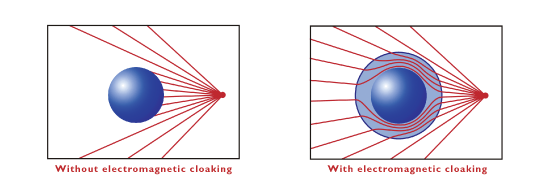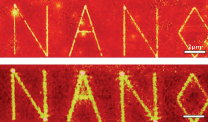THURSDAY, 1 OCTOBER 2009
 The greek root ‘meta’ means ‘beyond’ and in the context of a metamaterial, it refers to a man-made substance that has extraordinary properties not seen in any natural material. It is well known that the chemical structure of a material directly shapes its optical properties. More recently it has been recognised that the physical structure of a material can also play a crucial role. This discovery has led to a surge of research into ‘next generation materials’. By exploiting the influence of physical structure, metamaterials provide an unmatched freedom over the manipulation of light.
The greek root ‘meta’ means ‘beyond’ and in the context of a metamaterial, it refers to a man-made substance that has extraordinary properties not seen in any natural material. It is well known that the chemical structure of a material directly shapes its optical properties. More recently it has been recognised that the physical structure of a material can also play a crucial role. This discovery has led to a surge of research into ‘next generation materials’. By exploiting the influence of physical structure, metamaterials provide an unmatched freedom over the manipulation of light.A metamaterial is composed of an array of tiny building blocks designed to mimic the atoms of naturally occuring materials. These elements can be thought of as ‘artificial atoms’ and are carefully designed so that they resonate at a specific frequency, giving the material a unique electric and magnetic response. These ‘artificial atoms’ must be significantly smaller than the wavelength of the incident light. Consequently, the incoming light acts as if it is short-sighted – it cannot distinguish the individual elements and ‘sees’ instead a homogeneous medium with well-defined optical properties. The behaviour of the light is determined by the collective response of all the individual elements within the metamaterials.
Designed appropriately, metamaterials can have various distinctive and peculiar optical properties. Perhaps one of the most interesting is a negative refractive index. Light is refracted or bent on entering a material and the refractive index dictates both the direction and the angle of the bending. A material with a negative index of refraction will bend light in the opposite direction to that of conventional materials, which all have a positive index. Although this may appear innocuous, it lays the framework for a startling effect known as electromagnetic cloaking, or more colloquially as invisibility. By covering an object with an appropriate ‘meta-layer’, it can be completely shielded from incident light, making it invisible to an observer. To understand how this works, consider how an everyday opaque object is viewed. Imagine a spherical object such as an apple, resting on a table. Light hitting the apple will be scattered from it. The manner and angle at which it is scattered provides information regarding its position and texture. An observer can then collect this light and process it to give detailed information on the object. However, with our electromagnetic cloak, light arriving from behind the object is bent around it due to negative refraction in such a way that it arrives at the eye without any apparent change in path. There is no evidence of any obstacle in its path. The object doesn’t even cast a shadow. This effect was recently demonstrated successfully with infrared radiation using a nano-porous carpet structure constructed entirely of silicon. The carpet cloak was placed over an object and by mimicking the reflection of a completely flat surface, the object was successfully hidden. The ultimate goal is to extend the effect across the entire visible light spectrum and towards the famed ‘invisibility cloak’.
Metamaterials also hold the key to a powerful imaging tool, popularly known as the ‘super-lens’. These devices have demonstrated an ability to far surpass the resolution of conventional lenses giving unmatched detail. Current lenses work by collecting the light emitted or reflected from an object and focusing it into a clear image. However, there comes a point where details are simply too small to be resolved further. In physics, this point is known as the diffraction limit and for a long time it was believed to be a fundamental barrier arising from the wave-nature of light. Surprisingly, this restriction can be neatly side-stepped through the use of metamaterial lenses, offering unparalleled imaging power. In the case of a standard lens, the majority of an image passes though, but the finest details decompose rapidly after leaving the object and are lost forever. On the other hand, an appropriately designed ‘meta-lens’ is able to sustain and even amplify these elusive components until the final image is formed, including all the tiniest details. The super-lensing effect was predicted at the start of the century and since then such lenses have been successfully constructed, achieving accurate resolution down to 50 nanometres, ten times greater than the best glass lens can manage. This has particular implications in microscopy, where such lenses could be used to image tiny objects such as DNA and single molecules, which were previously too small to be observed directly. They could also be used to optically write patterns with the high level of detail currently only possible using techniques such as electron beam lithography, one use of which is to pattern nanoscale circuits.
Many of the initial successes with metamaterials were for manipulating light in the microwave region of the electromagnetic spectrum. Metamaterials must be composed of elements significantly smaller than the wavelength of the light, which has hindered their fabrication. The first successful demonstration of negative refraction, in 2001, involved a two-dimensional array of split copper rings. These copper rings were designed to respond to microwave radiation, with a wavelength of the order of centimetres. The rings therefore only needed to be on the scale of millimetres, which was no huge engineering challenge. The experiment proved for the first time some of the unique properties which had already been predicted by theory.
Metamaterials developed rapidly from this initial success and within a few years there were promising advances towards ‘optical metamaterials’, which resonate with infrared and visible light, hugely expanding their potential uses. The challenge lies in the fact that as we slide down the electromagnetic spectrum from microwaves to the visible, the wavelength of the light decreases by a factor of 10,000. In the optical region of the spectrum, light has a wavelength of around a micrometre, so the structural elements must be on the scale of nanometres. This has inspired a plethora of creative and ingenious designs. Metamaterials now take many shapes and forms; from intricate arrays of silver nanospheres, to precisely coupled gold nanorods and even repeating stacks of ‘nano-sandwiches’.
The manipulation of light has always been vastly important across the breadth of scientific research, from astronomy right through to biology and medicine. Conventionally, natural materials have been chosen and optimised to achieve this goal to the best of their abilities. Metamaterials can now offer a power and flexibility which has previously existed only in the dreams of science fiction. At this rate, when the last instalment of Harry Potter finally arrives on our cinema screens, his much-coveted invisibility cloak may already have become rather passé.
Nicholas Gibbons is a PhD student in the Department of Physics


